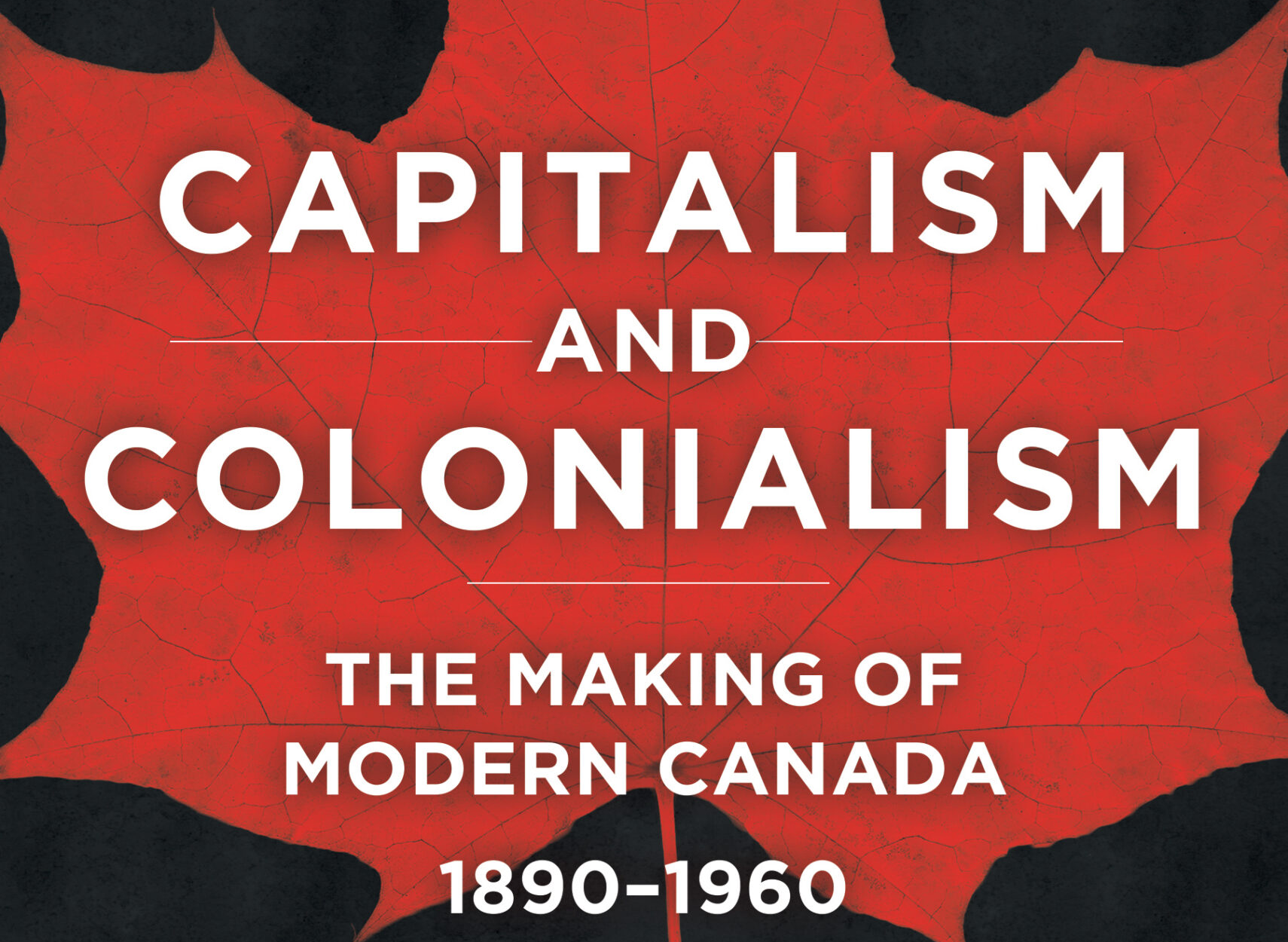
This week, I sat down with historian Bryan Palmer to discuss his latest endeavour, a three-volume history of colonialism and capitalism in Canada published by Lorimer. The first volume, Colonialism and Capitalism: Canada’s Origins 1500-1890, was published in September 2024. The second volume, Capitalism and Colonialism: The Making of Modern Canada 1890-1960, was published last month. A third volume is scheduled to be released in the not-too-distant future.
A remarkable work of historical synthesis and critical analysis, this trilogy probes the continuing legacy of colonialism in Canada. The books address how a craving for capital on the part of early European empires resulted in colonial dispossession, which then proved a foundation on which capitalism as a system was consolidated.
Bryan Palmer is professor emeritus and former Canada research chair in Canadian studies at Trent University in Peterborough, Ont. He is a fellow of the Royal Society of Canada, former editor of the academic journal Labour/Le Travail and author of numerous books and articles on the history of labour and the revolutionary left.
Adam King: First, congratulations on the gargantuan feat of assembling these books. They will no doubt serve as an invaluable resource for scholars and activists for years to come. Let’s start with what motivated you to write the books. Surely, there’s been somewhat of a proliferation of scholarly work reconsidering Canada’s colonial or settler-colonial past, present and future. Why Colonialism and Capitalism and Capitalism and Colonialism now?
Bryan Palmer: Thanks for those kind words, Adam.
I do hope the volumes prove useful for teachers, students and activists looking for a broad understanding of how colonialism and capitalism have been decisive in Canada’s development. I suppose four things motivated me to write the books, although the three volumes turned out to be different from the project I originally envisioned.
First, Jim Lorimer asked me to write a history of capitalism in Canada. This happened as COVID-19 shuttered us all, and I thought I could socially distance in my attic library and come up with a short book, which is what all publishers want. But I told Jim any history of capitalism would have to address colonialism as well. He agreed, and so I proceeded to read and to write, not quite appreciating at first what I was getting into.
Second, I was interested in doing such a history because in my last years of teaching at Trent University in Peterborough I often ran into resistance from students on my understanding of Canada’s development. I came to appreciate that many of the students I encountered in graduate courses were perfectly willing to see Canada as a colonial nation-state, but convincing them that colonialism could only be understood in relation to capitalism and its changing nature was a much tougher sell. So, I thought addressing this in a new history of Canada might be a useful contribution.
Third, I wanted after years of teaching about aspects of Canada’s past, to see if I could write a history that gestured toward conceptualizing the long historical arc of nation-state formation. This meant exploring Canadian history in all of its complexity: Indigenous-European relations in the earliest colonial years; First Nations dispossession; the changing contours of political economy and the elite figures and state actors often central to this material history; class formation and working-class life; and finally, resistance and alternative conceptions of what Canada might be.
All of this (and more) had to be brought into such a study.
Fourth, and finally, “settler colonialism” as a conceptual framework for understanding Canada is almost unquestioned in progressive circles. Yet, very few of those embracing this understanding have actually explored the long and complicated history of colonialism and capitalism. Settler colonialism as a paradigm pushes non-Indigenous people to address the colonialism at the heart of Canadian development. In this, and in many other ways, it has had a salutary effect. However, there are many periods in Canada’s history, and many aspects of that experience, where looking at colonialism and capitalism forces us to step outside of the homogenizing essence of a term like “settler colonialism.” This means addressing the extent to which not all settlers benefited equally from Indigenous dispossession and to come to grips with times and places where it most emphatically was capital and the state that orchestrated colonial subordination.
This is not to whitewash the settler experience and role in the colonial repression of the First Nations, Métis, and Inuit peoples inhabiting the land mass now known as Canada. If we want to build this society anew in ways that confront Indigenous dispossession, it will take coalitions and alliances of political opposition that unite all of the dispossessed. Of course, the first peoples to suffer alienation from their lands and lifeways over the long course of Canadian history will figure centrally in this opposition, but it will also be composed of others, alienated from their skills and labour, and suffering marginalization through racism and other exclusions. I wanted to write a history that could help to bring people who have suffered from colonialism and capitalism, as twin structures of oppression and exploitation, together in a politics of opposition.
It was a lot to undertake. But I felt there was no such account of Canada, colonialism and capitalism out there. It was, in my view, high time that there was such a book — it ended up being books — available to interested readers.
AK: Early in Volume 1, you write: “Nation-building, Canadian-style, constituted a concerted effort at dismantling other nations.” Can you recount for readers how you see colonialism shaping early Canadian capitalism? How did colonialism shape a particular form of capitalism in what became Canada, according to the argument of your books?
BP: Well, in some ways I might turn that question around slightly.
I see both colonialism and capitalism as intricately related, embedded in one another. Now, of course, there is no capitalism per se at the time of Indigenous-European contact, which for simplicity’s sake, let’s peg around [the year] 1500. Capitalism as a regime of accumulation resting on privatized property, the development of factories, mills, mines and other sites of profit, which is made out of lands and resources that Indigenous peoples first lived on and related to, and was made off the labours of working people, does not really come into its own in Canada until the 19th century. Colonialism predates this by centuries.
That said, capital as a socio-economic force certainly existed before capitalism had sunk its tentacles deep into everyday life. The craving for capital and its accumulation drove feudal absolutist states, governed by hereditary monarchies and their aristocratic supporters, into wars with one another in Europe and quests for riches throughout the world. This was on top of what they were extracting from peasants and other small producers throughout Europe. Dispossession through enclosures of common lands occurred in Europe, as did various other forms of subordination.
Of course, what happened in the making of a colonized North America was different, and Indigenous peoples’ dispossession has a uniquely brutal character, but in many ways, what happened in the Scottish Highlands, parts of the Irish countryside, and elsewhere in terms of dispossession, has parallels with what happened in the misnamed “New World.” Concentrated land holdings in pre-capitalist Europe could be quite brutal and were even sometimes rationalized by racializing populations of the poor. When Europeans encountered Indigenous peoples, they did have different and more strident ways of marking First Nations as “others,” but the general process of appropriation bore some similarities. A craving for accumulation animated elites and powerful dynasties throughout the feudal epoch, and as power concentrated in what we might call absolutist monarchies, that quest to concentrate wealth in fewer hands rather than distribute it more evenly throughout society was one hallmark of a slowly germinating capitalism.
As options closed within particular European lands, and advances in sea transport widened understandings of the world, empires competed for distant spoils. Merchants and “companies of adventurers,” as they were known, traversed the seas in search of lands they could locate such riches on, and transport them back to their patrons in royal courts. So capital, and pre-capitalist states, involved in an endless attempt to accumulate the largest share of what was perceived as a limited or finite supply of goods and riches, did structure colonialism.
The so-called “New World” was a place where goods and riches were sought. If gold and diamonds and exotic spices could not be located, at first (they would be found later), cod and beaver pelts could. Profit could be made on these commodities. The problem was that other peoples lived on the lands and frequented waterways and shorelines that were crucial to the harvesting of fish and fur. Those Indigenous peoples had to be drawn into the craving for capital, enticed to gather the desired commodities or at least not threaten seasonal fisheries. Technologies and tools, crudely manufactured goods and spirits, were available to Europeans to do this. And as the competing monarchies of Europe were often at war with one another, and those wars spilled over into the territories occupied by Indigenous peoples on the northern half of what is now the North American continent, First Nations had to be structured into alliances with those European states determined to build empires of overseas possessions. Colonies were capital, and generated capital.
As time progressed, and the beginnings of capitalism appeared, the lands of First Nations people became crucial for the growth of a timber trade, the development of private agricultural land, and the establishment of a wide array of productive enterprises, from small-scale blacksmithing or shoe-making shops, to coal mines and nail manufactories. These were the beginnings of a home market, in which goods were produced to sustain a growing non-Indigenous population of settlers. These settlers were of course divided by class differences, with elites controlling much of the society’s resources and the entire apparatus of governance.
None of this, which constituted the beginnings of Canada as a nation-state, would have been possible without the dispossession of Indigenous peoples. This is how colonization happened.
It was justified because the Europeans who came to Indigenous lands were armed with the self-confidence of godly superiority over “savages” and “pagans” who lacked Christian understandings of their place in the world. Pious Christians, even as they warred with other Christians, claimed the land by rationales like the “doctrine of discovery” — a religious justification for seizing territory inhabited by peoples judged “lesser” because they did not pray to a Christian god — or the legal fiction of “terra nullius.” That fig-leaf covered a multitude of sins. It rationalized the taking of land from peoples who, because they did not settle it in cities or develop structured agriculturally based communities, using the land as Europeans would, were inhabiting places that were judged to be empty, and hence there for the taking.
Capital, if not capitalism, thus lay behind empire’s early encroachments on Indigenous lifeways and lands. Those lands, in turn, provided the foundation of capitalism’s later development, which continued to rest on ongoing dispossession of Indigenous peoples as well as the exploitation of labouring people.
The state, which was constructed as a colonial means of governing, establishing and serving the interests of a ruling elite as the powerful “owner” of privatized lands and productive enterprises, became an overseer of sorts. It struck treaties that further entrenched colonization of Indigenous peoples and it orchestrated laws and boundaries within which both labouring people and First Nations, Métis, and Inuit were expected to exist. Together, colonialism and capitalism evolved as the structural foundations on which Canada emerged as a nation-state and material life within it developed.
For a nation-state that invests much in its cherished mythology of being “a peaceable kingdom,” this making of Canada was achieved dripping with blood and blistered by violence. It all began with capital, which fostered colonialism, which then sustained capitalism. At a certain point colonialism and capitalism were so intricately embedded in one another that distinguishing one from the other proves impossible.
AK: Building from here, it would be helpful to consider what “the reciprocal and interdependent nature of capitalism and colonialism” in Canada, as you put it, meant for the development of the Canadian state, especially given that this state contained within it an oppressed national minority in Quebec.
BP: One of Canada’s most striking peculiarities is that its colonialism is layered. The country begins as distinct colonies of clashing empires. France and England ultimately compete for the territory that is now Canada, a geography that originally saw the Dutch, the Spanish, and the Portuguese also struggling for the spoils of its seas and forests. Ultimately, the British prevail, and France is forced to cede its colonial foothold north of the St. Lawrence to Britain. In the 18th century, giving up all of what is now Canada seemed better than sacrificing the sugar plantations of Caribbean islands like Guadeloupe. Canada was, at the time, regarded as a costly and unproductive territory.
With Britain’s securing of Canadian colonies in 1763, the French empire said farewell to its habitants and seigneurs, which it had struggled to settle in the outpost of New France since the 17th century. So begins the conflict, as Lord Durham famously once said, of “two nations struggling in the bosom of a single state.” The problem with this assessment was that Canadian territories housed many nations, including countless First Nations. And there was not a single federal state in the 1830s that could have governed these disparate nations without generating tensions and conflicts.
A rebellion happened in 1837-38, and it was the first time in centuries of conflict that the British Empire did not really want the participation of First Nations warriors fighting alongside colonial Redcoats in the interests of preserving the Crown’s entitlement to territories it had simply asserted its entitlements to. In the War of 1812, Indigenous warriors won battles for the British against the Americans. During the Rebellions of 1837-38, those same Indigenous warriors were shunned. Something fundamental in the mindset of a colonial officialdom had crystallized.
Confederation would try to broker that change, among many other things. It papered over the divide of French and English within the nation-state, and it moved decisively in the direction of coercive assimilation with respect to Indigenous peoples. Increasingly those First Nations, Métis (and these were yet another reminder of French/English/Scottish/Indigenous histories of entanglement) and Inuit peoples found themselves regarded as wards of the consolidated, Confederated Dominion of Canada. Capitalism ramped up that colonial project of subordination.
Within Quebec, it conceded the cultural realm to the Québécois elite of merchants, landholding seigneurs and a Catholic Church hierarchy. This privileged layer of society was allowed some entre into the English-dominated governing circles, as long as its members did not rock the boat of actual power. British colonial authorities placated the French-speaking population and these compromising leaders by allowing vestiges of New France to remain: its religious institutions, forms of law, educational endeavours and the like were allowed to continue as they had for generations. But it appropriated the truly profitable realm of the French-speaking province’s material life in ways that concentrated economic authority in English-speaking hands.
By the 20th century, Quebec’s financial institutions, paper mills, hydroelectricity, asbestos mines and large factories were controlled by English-speaking capital. Canadian or American capital dominated Quebec during the 20th century, with the United States empire replacing Britain as a key player in the Canadian economy. This was all brokered by the long-established French-speaking elite, now ensconced in the established provincial state. Politicians such as then-premier Maurice Duplessis were content to parcel out Quebec’s resources and profitable enterprises to English-speaking capital as long as they controlled the reigns keeping much of the provincial population securely within their grasp.
This produced a stultifying atmosphere, described by many critics as “the Great Darkness,” which only lifted somewhat with the Quiet Revolution of the 1960s and the not-so-quiet revolt of many of Quebec’s younger generation and militant workers. This radical nationalist upheaval and demand for a thaw in the seemingly ice-bound traditionalism of colonized, capitalist Quebec culminated in momentous changes in the social attitudes of la belle province. What had been one of the most conservative regional societies in Canada became, in the mainstreaming of anti-colonialism in the 1960s, one of the most radical; a religiously-ordered Quebec became a province as dedicated to secularism as any other.
The resistance to capitalism culminated in violence with the Front de libération du Québec-precipitated October Crisis of 1970 occasioned by the murder of a government official and the declaration of Ottawa’s War Measures Act. This imposed repression witnessed the suspension of civil liberties, and the arrests and detention of hundreds of innocent militants. Mobilizations of opposition to this heavy-handed repression throughout the country resulted. The Common Front general strikes and working-class protests that followed shortly thereafter established Quebec as the poster child of North American radical syndicalism.
Meanwhile, for many of Quebec’s Indigenous peoples, their struggles for recognition, sovereignty and redress were buried under the tsunami of French-Canadian nationalism. Anti-colonialism on one front left anti-colonialism on another sidelined.
AK: This would perhaps be a good place to consider some of the forms taken by Indigenous resistance to the consolidation of Canadian capitalism and colonial dispossession. In the late-19th and early-20th century, how did Indigenous peoples politically organize themselves in opposition to the emerging colonial state, and how were these forms of resistance ultimately suppressed or incorporated?
BP: Indigenous resilience and resistance run through the history of Canada.
The high-water mark of this resistance to the consolidation of Canadian capitalism and colonialism in the Confederation era are the two Riel Rebellions of 1869-70 and 1885, both of which were insurrectionary wars of resistance, challenging colonialism. Led by the Métis of the Northwest, the 1869-70 uprising established a provisional government. It was able to do this because Confederation had not really consolidated, the Hudson’s Bay Company was still the de facto state in the Northwest and federal authority lacked the means to deploy troops quickly, the Canadian Pacific Railroad not having been built.
The Métis found the colonial mentality that shunted them to the sidelines in the creation of a new province, Manitoba, repugnant, but in the end, for all their military prowess and political sagacity, they (and [Louis] Riel especially) perhaps trusted too much in the goodwill of an emerging Canadian nation-state. Ottawa prevaricated and manoeuvred and eventually bought the Hudson’s Bay Company lands in the Northwest. It was content to leave a distinct component of the region’s population sidelined in negotiations among empire’s various emissaries. Promises were made to the Métis, and they were broken, their leader, Louis Riel, going into exile in the U.S.
The second War of Resistance, in 1885, drew some First Nations support to the Métis revolt, and Riel, enticed to return to his homeland to lead the insurrection, was a different (more messianic than militant) leader than he had been in 1870. He also thought, mistakenly, that the situation in 1885 was the same as it had been in 1870. He was wrong. The Canadian state had taken strides forward in its consolidation: Ottawa governed, not the Hudson’s Bay Company, and the construction of the transcontinental railway allowed troop movements from central Canada to inundate the prairies. Riel, his competent military leader, Gabriel Dumont, and the Métis and First Nations warriors who followed them into battle, were routed.
The tragedy of the 1880s was that despite an emerging labour movement consolidating in the trade unions and Knights of Labor assemblies of the time, it did not make common cause with the insurrection in the Northwest. The strikes, political campaigns of labour candidates and consolidating organizations of workers were largely isolated in their nascent struggles against capitalism from the anti-colonial war of resistance in the Northwest. Opponents of capitalism and colonialism have lived with this legacy of division subsequently.
During the next major working-class upheaval in the First World War and immediate post-war years, as Canadian labour mounted a campaign of resistance that spread through general and sympathetic strikes, and mobilized workers against war and the profit system, demanding collective bargaining rights and pursuing a politics of class struggle, Indigenous peoples organized politically as well.
It was difficult for workers to organize and challenge capital, but the state put even more curbs on Indigenous organization, going so far as to pass legislation in the late 1920s that curbed the right of Indigenous peoples to form political associations. During the Great Depression, when Communist Party and Co-operative Commonwealth organizers led worker mobilizations against unemployment and promoted industrial unionism, most Indigenous peoples struggled to survive. A flurry of political organization among Indigenous peoples occurred in the 1940s, much of it directed toward reforms of the Indian Act, first passed in the 1870s. These reforms occurred in 1951, but actually changed very little.
The crucial decade for Indigenous political organization was the 1960s, when First Nations, Métis and Inuit peoples’ organizations exploded. There were more Indigenous political and voluntary associations formed in the years 1960-1973 (86) than in the entire period from the late 18th century to 1959 (61).
A Red Power movement emerged, led by young Indigenous militants. It galvanized demonstrations, occupations and blockades of parks and bridges. Red Power advocates managed to turn back attempts by the government of Pierre Elliott Trudeau to drive one more nail of coercive assimilation into the colonizing coffin in 1969, but this legislative effort was rebuffed. Harold Cardinal played a role in defeating Trudeau’s White Paper, which proposed doing away with the Indian Act and all of its treaty entitlements. Cardinal’s contribution to the Indigenous counter to the government’s White Paper, known as the Red Paper, helped the young Indigenous leader become a well-known figure in Canada. Cardinal also became a best-selling Canadian author with his book The Unjust Society (1969).
In many ways, Indigenous opposition grew out of the Red Power movement of the 1960s. For the past 40 years, from the Oka Uprising of the 1990s through the rise of Idle No More and the initiatives and campaigns associated with residential school revelations and missing and murdered Indigenous women and girls, the radical sensibilities of the 1960s have infused Indigenous protests. They have been instilled with a vigour that was once evident in mobilizations of Canadian workers. Labour’s voice of opposition, however, has quieted with capitalism’s neoliberal attacks on jobs, trade union entitlements, human rights and the workers’ purchasing power.
AK: Let’s shift to the development of the working class in Canada. There can be a tendency in the settler colonialism framework to marginalize, if not obliterate, class distinctions, as though white settlers and their descendants were and are roughly equal beneficiaries of the violent dispossession of Indigenous peoples. Your books are of course at pains to centre class and the historical development of the working class in Canada, including the often-overlooked Indigenous portion of that working class.
Can you tell us something about how you see the making of the working class in Canada fitting into the story of Canadian colonialism?
BP: This is in some ways the pivotal question. If we want to eliminate colonialism we must, as Glen Coulthard has said, eliminate capitalism. The corollary is equally true. You cannot have capitalism survive, I think, shorn of colonialism. Capitalism and colonialism are so entwined as to be inseparable at this historic juncture. So, it is a two-pronged fight.
How is the struggle against capitalism and colonialism to be forged? In my view, it needs to bring together all of those who share an interest in ending oppression and exploitation, which are the defining features of both colonialism and capitalism. Non-Indigenous people have a significant burden to prove to Indigenous people that they treat the dispossession and colonial subordination, repression, and at times genocide of Indigenous people as a shameful historic actuality. This cries out to be addressed, and not just rhetorically. Land acknowledgements are fine, but what we need are struggles that aim to ensure that equality is achieved and the wrongs of the past are never either denied or repeated.
Workers, too, are dispossessed. Indigenous lands were taken, Indigenous childhoods were hijacked and debased and worse in residential schools, their grounds now scarred with unmarked graves. Workers are routinely robbed of the products of their labour. Their children are earmarked for menial and insecure lives. If the two experiences are not the same — and I am not arguing that they are — there is sufficient comparability to warrant acts of solidarity and common struggles.
The onus of responsibility may lay with what remains of the strongest arm of the working class, the trade unions. These organizations need to rally round the standard, “An injury to one is an injury to all,” and unite with Indigenous movements for social justice, environmental preservation, and unequivocal refusal to countenance any and all racist acts, be they committed by states or individuals, police forces or corporations, hospitals or educational institutions.
There is, I believe, common ground. It will not be walked on together, in collective struggle, without acknowledgement of how settlers have benefited from Indigenous dispossession. That has happened. And there are indeed moments in the history of colonialism and capitalism in Canada — too many of them — when settlers have behaved abominably toward Indigenous peoples. That demands calling out, and such despicable behaviour can of course not be tolerated ever again.
But it must also be recognized that there is a fundamental differentiation within Canadian society, and this differentiation has always existed, in terms of who benefits and in what ways from colonialism.
Forty years ago on the left, if the question was posed, “Who benefited from the dispossession of Indigenous peoples in Canada, the poor homesteader eking out a living north of Brandon and the immigrant pork packer in a Toronto factory, or the Canadian Pacific Railroad and Joseph Flavelle?” The answer, I think, would have been obvious. Today, and perhaps I am wrong, my sense is that the answer would often be far more equivocal. If we can and must acknowledge that colonialism provides workers with certain benefits, of which waged labour is one, it is perhaps time to acknowledge that capitalism provides that entitlement in ways that are themselves punishing and alienating.
Finally, and this is likely to be contentious, although I’m certain that many Indigenous militants know it is true, there is a proverbial elephant in the room: capitalism incorporates. It has done this with workers and their leaders, in both the economic sphere of the unions and in the political arena, with parties that supposedly speak for the working class (and now all parties seem to do this, out of all sides of their mouths). But capitalism is also doing this with Indigenous leaders, some of whom are buying into money, no matter where it comes from (oil pipelines, rare earth mineral extraction, military installations). This problem has been exacerbated with [U.S. President Donald] Trump’s tariffs, and the pressure now exerted on all Canadians to fall in line with ecologically destructive and economically ill-advised quick fix solutions to the contemporary crisis.
Red capitalism is ultimately a recipe for colonialism’s continuities.
AK: In Volume 2, you deal more with contemporary forms of Indigenous and working-class resistance. Yet a central theme running through these discussions is the inability of these strands of dissent to come together in a sustained and oppositional critique of capitalism.
Tell us about how the book conceptualizes this history. What do you think explains the all-too-frequent distance between Indigenous and labour-based resistance to Canadian capitalism?
BP: For decades the separation of the anti-colonial struggles of Indigenous peoples and the potentially anti-capitalist mobilizations of the working class were indeed distinct, separate, and seemingly irretrievably divided. This was a fact. It was engineered out of the ideological fabric of society, so strongly racist and complacent when it came to the treatment of Indigenous peoples, who existed in worlds apart from so many of Canada’s workers, be they native born or immigrant, their wages high or low.
That said, we should not forget that there are historic ties that link labouring Indigenous peoples and working-class settlers. They toiled together in many work settings, including on British Columbia’s docks and prairie harvests and urban high steel construction sites. In addition, there have always been Canadians who balked at being incorporated into the colonial mainstream, however comfortable a place it has been for the majority. Intellectual figures in the Knights of Labor in the 1880s offered voices of calming assessment of just why Riel’s rebels were mounting an insurrectionary opposition, and Riel’s secretary, William Henry Jackson/Honoré Jaxon, tried to build a union of Métis and settlers to defeat the plutocrats. Throughout history, Indigenous peoples’ struggles have always had the support of a beleaguered minority of far-seeing supporters.
But most Canadians, of course, were not in this pro-Indigenous camp. It could be claimed that this was the reality for almost the entirety of Canadian history, up to the 1960s. In Volume 3, however, I take pains to show how something changed with the 1960s. The youth radicalization of that decade was so influential in the rise of Red Power, and it crested in a proliferation of movements, extending into anti-war, labour, and feminist mobilization. This radicalism emphasized the necessity for those opposed to capitalism and colonialism to shed the limiting legacies of the past, and make common cause with all oppressed people: the poor, the marginal, the exploited worker, dispossessed Indigenous peoples, the Québécois, women, gays — the vast majority of Canadians who were outside the ranks of the powerful elite constituted potential foot soldiers in a social revolt.
Today, unlike in the past, the common sense of young people is often anti-racist, sensitive to Indigenous dispossession and ongoing oppression. At the same time, many of those young people are not especially pro-labour or well-versed in the historical making of the workers’ movement. If they were transported back to the 1930s, they would have very little empathy for First Nations, Métis and Inuit people. They would either occupy lives very different from them, or, even more likely, be hived off from them. They would not see Indigenous subordination, poverty and colonial dispossession as their problem. But they would have been in ready solidarity with the unemployed and the General Motors strikers. So, the tide of understanding has shifted somewhat.
What was commonsensical in 1930 is misunderstood, even mystified, today, and vice versa. This separation of the potential oppositions to colonialism and capitalism needed to be overcome in the 1930s, just as it needs to be transcended today. The struggle to bring these two components of resistance together is fundamental to taking our futures back, wresting them from powerful colonial-capitalist forces who have already squandered so much and may lead us all to the abyss, if we are not already there.
AK: Volume 2 concludes in the mid-20th century, in many ways the high point of labour’s institutional strength, incorporated as it was in the post-war settlement. Yet this is also right on the eve of massive upsurges in left activism, rank-and-file labour militancy and eventually, Indigenous resurgence in the Red Power movement. Can you give us a hint of where Volume 3 will take us?
BP: What capitalism and its servile state gave with a hand of generosity in the post-war settlement was never offered freely. The joined hands of capital and the state were twisted hard to make concessions by the class struggle momentum of the 1940s. Workers won whatever institutional power they would ever possess in hard-fought battles. In the 1960s, young and militant workers sought to extend that power in a wave of wildcat strikes waged amid the seeming generalized prosperity and relatively full employment of the flush, mid-1960s. Trade unions in Canada expanded and worker militancy continued into the mid-1970s. Capital thought the good times would go on forever. The labour movement, having eliminated the communist opposition in its ranks in the 1950s Cold War, was content to go along for the ride. It thought the post-war settlement was a permanent fixture of class relations.
It was not. From 1975 to the present, Canadian capitalism confronted a profitability crisis, stagflation, deindustrialization and plant closures, globalization and free trade, international currency crises, a 2007-09 financial meltdown, a deadly pandemic, and now, an American president who enjoys turning the tables on just about everyone, including Canada. The terms of trade in the class struggle shifted dramatically from a workers’ movement — with a 1960s and 1970s New Communist presence — that was confident and combative, to a whittled away trade unionism that was in retreat, at times on the run, and an extra-parliamentary left that was severely weakened by repression and the decline of organized labour.
To be fair, Canada’s unions faced a formidable set of challenges as capital’s profitability crunch in the 1970s opened the door to neoliberal austerity initiatives that escalated over the course of the late 20th and early 21st centuries. Draconian assaults on working-class well-being resulted. Wages stagnated and social programs were chopped. Health and education funding came under attack. Strikes were virtually outlawed, and unemployment, homelessness, and anomie ran roughshod throughout society, affecting young people in particularly devastating ways. The political spectrum shifted decisively to the right.
The last 50 years have been a nightmare for the working class, and absolute immiseration — once the laughingstock of anti-Marxist trolls — is now something that stalks many a poor household. Volume 3 outlines this sad denouement. But it also points to an irrepressible capacity to fight back, evident in all manner of struggles of organized workers, anti-poverty activists and left-wing crusaders.
One reason an alliance of all of the dispossessed remains both possible and potentially liberating, is that while the labour movement and working-class people in general suffered defeats in the post-1975 years, Indigenous protest never quieted and showed a capacity to rise up angry in its opposition to colonialism and, increasingly, to capitalism. The 1960s Red Power movement lived to raise its militant fist again and again, offering all oppositions a sense of what was possible to do if a fighting spirit was kept alive.
Bringing this Indigenous militancy and the beaten back but by no means down and out workers’ opposition into alignment is not just a pipe dream: it is the dire necessity of our time. Colonialism and capitalism have dug us into a hell hole of devastation, even possibly destruction. They cannot dig us out, and have no interest in doing so. Their bread is buttered in our debilitation.
We need to bring together a broad mass of those who, to varying degrees, have experienced the immiseration on offer from colonialism and capitalism, and stand prepared not to stand for it anymore.
Recent Class Struggle Issues
- October 13 | Charges For Workers’ Rights Violations Drop 90% In Ontario
- October 6 | The Minimum Wage Increase In 5 Provinces Isn’t Enough
- September 29 | Canada Post’s Moment Of Reckoning May Finally Be Here
- September 22 | Unions Improve Social Well-Being Even For Non-Members







